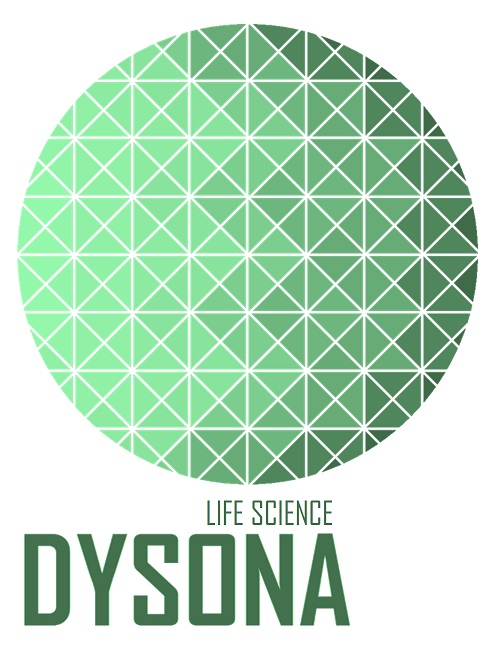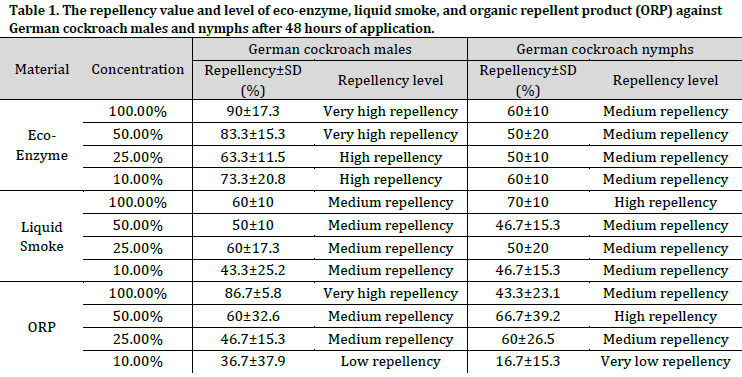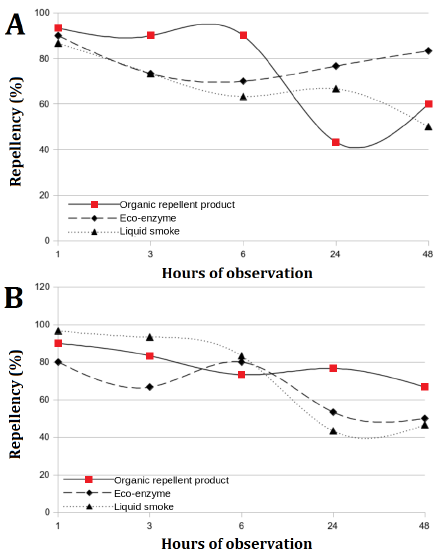Robby Jannatan 1*; Resti Rahayu 1
1, Department of Biology, Faculty of Mathematics and Natural Sciences, Andalas University, Indonesia
E-mail:
robbyjannatan@sci.unand.ac.id
Received: 11/03/2023
Acceptance: 13/04/2023
Available Online: 14/04/2023
Published: 01/10/2023

Manuscript link
http://dx.doi.org/10.30493/DLS.2023.389336
Abstract
The German cockroach is a widely spread household insect pest. Repellent products are usually used to repel this pest from stored foods and houses. The present study investigates the effectiveness of repellents produced from organic kitchen waste against German cockroaches. For that purpose, two types of repellents were prepared from mixed natural kitchen waste (eco-enzyme) and coconut shells (liquid smoke). The repellent test was conducted using four different concentrations of eco-enzyme and liquid smoke on male and nymph German cockroaches. The observed repellency of eco-enzyme against cockroach males was high to very high (73.3-90%), while liquid smoke repellency was medium (43.3-60%). However, the repellent effect of both materials was higher than that of the control organic repellent product. Therefore, eco-enzyme and liquid smoke can be developed as eco-friendly repellent agents against German cockroach.
Keywords: Blattella germanica, Repellency test, Eco-enzyme, Liquid smoke, Organic household
Introduction
The German cockroach is a household invasive and widely distributed pest throughout the world, dwelling in human communities [1][2]. German cockroach infestations are increasing and significantly impact asthma prevalence throughout the decades [3]. German cockroaches also carry bacterial contamination on the outside and inside of their body surface, causing a health risk in various environments [4].
Aerosol and bait insecticides are used as a rapid method to eliminate German cockroaches. However, the continuous and uncontrolled use of insecticides resulted in this insect becoming resistant to 42 different insecticide active ingredients [5]. Synthetic insecticide groups that cause the most resistance are organophosphates, organochlorides, pyrethroids, and carbamates [6]. Therefore, the new trend nowadays is the use of repellent materials, such as essential oils [7], in order to limit and control the number of German cockroaches in urban environments.
The potential of essential oils in repelling German cockroaches has been widely investigated. In this context, various natural repellents from essential oils and plant extracts including papaya leaf (Carica papaya) [8], citronella grass essential oil (Cymbopogon nardus) [7], Noni (Morinda citrifolia) [9], Lemongrass (Cymbopogon flexuosus) [10], Cymbopogon winterianus, Eucalyptus globulus, and Citrus hystrix [11] were evaluated. Considering these works, the development of insect-repellent resources is not limited to essential oils, and the repellent potential of other materials, such as organic household kitchen waste, can be explored.
Eco-enzyme and liquid smoke are organic household kitchen waste materials that can be used as repellent agents after being processed. Eco-enzyme is a liquid fermentation produced from household fruit and vegetable waste, brown sugar, and water that has a unique smell depending on the original fermented material. The fermentation of orange peel provides a distinctive sour aroma [12]. The color, aroma, and acidity of eco-enzyme depend on the length of the fermentation process [13]. Eco-enzyme contains citric acids and biocatalytic properties of amylase, lipase, and protease [14], in addition to many bioactive compounds such as alkaloids, flavonoids, saponins, and tannins [13]. Liquid smoke, on the other hand, is produced from the pyrolysis of wood and other plant parts. This material also has a distinctive sour aroma with a proven repellent effect on Culex pipiens pallens, Aedes togoi mosquitoes [15], Reticulitermes speratus termites [16][17], Captotermes curvignathus [18], and Captotermes formosanus [19]. However, the repellency of these compounds to German cockroaches has not been explored yet.
The present study was conducted to investigate the repellent effect of several concentrations of eco-enzyme and liquid smoke against German cockroaches compared to an essential oil based natural repellent product.
Material and Methods
Insects
German cockroach males and nymphs from the Palembang population (PLZ-PLM) were used in the current study. This population was originally collected from several grocery stores in Palembang, South Sumatra, Indonesia. PLZ-PLM is resistant to propoxur up to 1332 folds (extremely high resistance) [20]. Since 2017, the PLZ-PLM population has been reared according to [9] at the Animal Physiology Laboratory, Department of Biology, Universitas Andalas, Indonesia. German cockroaches were kept in a 16 liters plastic container and fed ad libitum with cat food (Pedigree) and water every four days. Cockroaches were reared at a humidity ranging from 84 to 86 %, a temperatures ranging from 24-28oC, and a photoperiod of 12:12.
Repellent preparation
The production of eco-enzyme was carried out according to [12]. Organic household kitchen wastes (orange peel 50%, lime peel 30%, turmeric 15%, and mint leaves 5%)were used in the preparation of the eco-enzyme. All of these materials were first washed in flowing water and then cut into small pieces. 500 g of brown sugar was placed in 5 liters of water and stirred until completely dissolved. A total of 1.5 kg of kitchen waste was added to the brown sugar solution. The mixture was then left to ferment for three months at room temperature (23-25 °C). During this period, the mixture was stirred once a week to remove the gas trapped in the plastic container. After the fermentation process, the solution was filtered through a 1 mm pore sieve and preserved for later use.The liquid smoke tested in this study was sourced from a local practitioner and was originally prepared from the pyrolysis process of coconut shells. Additionally, an organic repellent product (ORP) (Evodis Heritage) derived from essential oils, was used for comparison. The active ingredients of this product are lemongrass, patchouli, clove leaf, cinnamon silk, sweet fennel, and lemon essential oils. Distilled water was used to reach four different concentrations (100 %, 50 %, 25 %, and 10%) of each tested material.
Repellency test
The repellent effect of the used natural products against German cockroaches was assessed according to the method of [9]. For that purpose, a filter paper (15 cm in diameter) was divided into two equal parts. One ml of each tested material (eco-enzyme, liquid smoke, or organic repellent product) of each concentration (100%, 50%, 25%, or 10%) was distributed on one half of the filter paper while the second half received no treatment (Control). The filter halves were then left to dry for 30 minutes. The filter paper halves (a treated half and a control half) were then fitted into plastic containers of similar size (15 cm in diameter). The top inside of the plastic containers was greased with petroleum oil to prevent the insects from escaping during observation. Then, ten German cockroaches (males or nymphs) were placed in the middle of each plastic container. The distribution of German cockroaches on each filter paper was observed after 1, 3, 6, 24, and 48 hours. Each treatment was replicated three times.
Data analysis
The repellency value was analyzed using the following formula [21]:

T = Number of cockroaches found in the treated area
N = Total number of cockroaches used
The repellency level of each substance was then estimated as follows [22]:
Repellency value <0.1% is level 0 (Not repellent)
Repellency value of 0.1-20% is level I (Very low repellency)
Repellency value of 20.1-40% is level II (Low repellency)
Repellency value of 40.1-60% is level III (Medium repellency)
Repellency value of 60.1-80% is level IV (High repellency)
Repellency value >80.1 is level V (Very high repellency)
Results
The repellent activity on German cockroach males
The repellency level of eco-enzyme toward German cockroach males ranged between high to very high (73.3-90%) (Table 1). It is also worth noting that the repellent effect of eco-enzyme on German cockroach males remained in that range even after 48 hours of application (at 50% concentration) (Fig. 1 A). On the other hand, the repellency value of liquid smoke toward German cockroach males was notably lower (43.3-60%) (medium repellency at all concentrations) (Table 1). It was also noted that liquid smoke scored the lowest male repellency among the tested materials after 48 hours using 50% concentration (Fig. 1 A). The organic repellent product had a repellency value ranging from 36.7-86.7% (low repellency to very high repellency). This observation means that the repellent effect of this substance on German cockroach males was heavily influenced by its concentration compared to other used materials (Table 1). Additionally, it was observed that ORP maintained a very high repellency (>80%) during the first 6 hours of application (at 50% concentration). However, this effectiveness was notably decreased after 24 hours (Fig. 1 A).
The repellent activity on German cockroach nymphs
The repellency values of eco-enzyme and liquid smoke against cockroach nymphs were 50-60% and 46.7-70%, respectively. This means that both materials had a medium repellency against cockroach nymphs at all concentrations except for 100% liquid smoke (Table 1). It is worth noting that the effectiveness of both materials (at 50% concentration) in repelling cockroach nymphs decreased substantially after 24 hours of application (Fig. 1 B). Meanwhile, the organic repellent product had a a reppelency ranging from very low (at 10% concentration) to high (at 50% concentration) (Table 1). Additionally, ORP had higher repellency against nymphs compared to eco-enzyme and liquid smoke (at 50% concentration) after 24 and 48 hours of application (Fig. 1 B).


Discussion
The present study found that the level of repellency of eco-enzyme ranged from high to very high against male cockroaches with a medium repellency against nymph cockroaches. Even at a concentration of 10%, eco-enzyme was able to provide repellency values of 60% and 73.3% in nymphs and male cockroaches, respectively. this observation indicates that eco-enzyme can be an effective repellent against these pests. This high level of repellency might be attributed to the distinctive sour aroma produced after the fermentation process during the preparation of eco-enzyme. According to a previous study [23], acetic acid is the major constituent of eco-enzyme, followed by sugar, protein, alcohol, and enzymes. Thus, eco-enzyme has the potential of being used as an anti-bacterial agent, in addition to its insect-repellent properties [24].
Similar to eco-enzyme, liquid smoke had a noticeable repellent effect on German cockroaches. This repellency was medium to high in nymphs and was the highest among the used materials during the first six hours of application (at 50% concentration). Liquid smoke is characterized by a distinctive aroma due to the pyrolysis process of coconut shells, which might justify the repellent effect on cockroaches. Similar repellency activity (80% effective) of Japanese oak (Quercus crispula) liquid smoke on Reticulitermes speratus was reported [16].Previous study [15] also reported that liquid smoke provided seven hours of protection against Aedes togoi at a concentration of 40-60%. Although there is no clear identification of the substances contained in coconut shell liquid smoke used in the current study, several studies reported that acids and phenols are the main active components [16][17][19] which have a general insect-repelling effect. In fact, a previous report showed that a lethal concentration of liquid smoke from coconut shells could control termites Odontotermes sp. and striped mealy bugs (Ferrisia virgate) [25]. On the other hand, the organic repellent product had a lower repellency compared to eco-enzyme and liquid smoke, which is most likely due to the rapid evaporation of essential oils. Therefore, eco-enzyme and liquid smoke can be nominated for further development and research as efficient repellent agents against pesticide-resistant German cockroach populations.
Conclusion
The present study investigated the repellent activities of eco-enzyme and liquid smoke produced from organic kitchen waste against PLZ-PLM German cockroach population. The repellency level of eco-enzyme against cockroach males was high to very high (73.3-90%), while medium (43.3-60%) repellency levels were observed using liquid smoke. Furthermore, the repellent levels of eco-enzyme and liquid smoke were higher than that of the organic repellent product. Thus, eco-enzyme and liquid smoke can be further developed as eco-friendly repellent agents made from organic household kitchen waste.
References
| 1 | Tang Q, Bourguignon T, Willenmse L, De Coninck E, Evans T. Global spread of the German cockroach, Blattella germanica. Biol. Invasions. 2019;21(3):693-707. DOI |
| 2 | Fardisi M, Gondhalekar AD, Ashbrook AR, Scharf ME. Rapid evolutionary responses to insecticide resistance management interventions by the German cockroach (Blattella germanica L.). Sci. Rep. 2019;9(1):8292. DOI |
| 3 | Nasirian H. Contamination of cockroaches (Insecta: Blattaria) to medically fungi: A systematic review and meta-analysis. J. Mycol. Med. 2017;27(4):427-48. DOI |
| 4 | Nasirian H. Recent cockroach bacterial contamination trend in the human dwelling environments: A systematic review and meta-analysis. Bangladesh J. Medical Sci. 2019;18(3):540-5. DOI |
| 5 | Zhu F, Lavine L, O’Neal S, Lavine M, Foss C, Walsh D. Insecticide resistance and management strategies in urban ecosystems. Insects. 2016;7(1):2. DOI |
| 6 | Naqqash MN, Gökçe A, Bakhsh A, Salim M. Insecticide resistance and its molecular basis in urban insect pests. Parasitol. Res. 2016;115(4):1363-73. DOI |
| 7 | Jannatan R, Rahayu R. Fumigant toxicity and repellency of citronella grass essential oil (Cymbopogon nardus (L.) Rendle) to German cockroaches (Blattella germanica L.). Eur. J. Biol. Res. 2021;11(3):267-73. DOI |
| 8 | Rahayu R, Darmis A, Jannatan R. Potency of Papaya Leaf (Carica papaya L.) as Toxicant and repellent against German cockroach (Blattella germanica L.). Pak. J. Biol. Sci. 2020;23(2):126-31. DOI |
| 9 | Rahayu R, Putri Sury A, Herwina H, Jannatan R. Efficacy of noni (Morinda citrifolia L.) ethanolic leaf extract against German cockroach (Blattella germanica L.). Pak. J. Biol. Sci. 2021;24(5):629–35. DOI |
| 10 | Rahayu R, Mairawita M, Jannatan R. Efficacy and residual activity of lemongrass essential oil (Cymbopogon flexuosus) against German cockroaches (Blattella germanica). J. Entomol. 2018;15(3):149–54. DOI |
| 11 | Chooluck K, Teeranachaideekul V, Jintapattanakit A, Lomarat P, Phechkrajang C. Repellency effects of essential oils of Cymbopogon winterianus, Eucalyptus globulus, Citrus hystrix and their major constituents against adult German cockroach (Blattella germanica Linnaeus (Blattaria: Blattellidae). Jordan J. Biol. Sci. 2019;12(4):519-23. |
| 12 | Vama L, Cherekar MN. Production, extraction and uses of eco-enzyme using citrus fruit waste: wealth from waste. Asian J. Microbiol. Biotechnol. Environ. Sci. 2020;22(2):346-51. |
| 13 | Rusdianasari R, Syakdani A, Zaman M, Sari FF, Nasyta NP, Amalia R. Utilization of eco-enzyme from fruit skin waste as hand sanitizer. Asian J. Appl. Res. Community Dev. Empowerment. 2021;5(3):23-7. DOI |
| 14 | Rasit N, Hwe Fern L, Ab Karim Ghani WAW. Production and characterization of eco enzyme produced from tomato and orange wastes and its influence on the aquaculture sludge. Int. J. Civ. Eng. Technol. 2019;10(3):967-80. |
| 15 | Kiarie-Makara MW, Yoon HS, Lee DK. Repellent efficacy of wood vinegar against Culex pipiens pallens and Aedes togoi (Diptera: Culicidae) under laboratory and semi-field conditions. Entomol. Res. 2010;40(2):97-103. DOI |
| 16 | Yamada H, Shibutani S, Yatagai M. The repellent activity of wood vinegar and its volatile components against Japanese subterranean termites, Reticulitermes speratus. Wood Carbonization Res. 2012;8(2):69-76. DOI |
| 17 | Oramahi HA, Yoshimura T. Antifungal and antitermitic activities of wood vinegar from Vitex pubescens Vahl. J. Wood Sci. 2013;59(4):344-50. DOI |
| 18 | Rosalina, Tedja T, Riani E, Sugiarti S. An environmental friendly pesticide from bintaro (Cerbera odollam Gaertn) liquid smoke for pine wood preservation against a subterranean termite Captotermes curvignathus Holmgren attack. Rasāyan J. Chem. 2016;9(3):438-43. |
| 19 | Oramahi HA, Yoshimura T, Diba F, Setyawati D, Nurhaida. Antifungal and antitermitic activities of wood vinegar from oil palm trunk. J. Wood Sci. 2018;64(3):311-7. DOI |
| 20 | Nurseha T, Rahayu R. Insecticide resistance in Blattella germanica l. (dictyoptera: blattellidae ) from bukittinggi and palembang against propoxur. World J. Pharm. Life Sci. 2019;5(6):99-103. |
| 21 | Thavara U, Tawatsin A, Bhakdeenuan P, Wongsinkongman P, Boonruad T, Bansiddhi J, Chavalittumrong P, Komalamisra N, Siriyasatien P, Mulla MS. Repellent activity of essential oils against cockroaches (Dictyoptera: Blattidae, Blattellidae, and Blaberidae) in Thailand. Southeast Asian J. Trop. Med. Public Health. 2007;38(4):663-73. |
| 22 | Dales MJ. A review of plant materials used for controlling insect pests of stored products. Bulletin of the Natural Resources Institute. 1996:84 |
| 23 | Samriti SS, Arya A. Garbage enzyme: A study on compositional analysis of kitchen waste ferments. Pharma Innov. J. 2019;8(4):1193-7. |
| 24 | Mavani HA, Tew IM, Wong L, Yew HZ, Mahyuddin A, Ahmad Ghazali R, Pow EH. Antimicrobial efficacy of fruit peels eco-enzyme against Enterococcus faecalis: An in vitro study. Int. J. Environ. Res. Public Health. 2020;17(14):5107. DOI |
| 25 | Wititsiri S. Production of wood vinegars from coconut shells and additional materials for control of termite workers, Odontotermes sp. and striped mealy bugs, Ferrisia virgata. Songklanakarin J. Sci. Technol. 2011;33(3):349-54. |
Cite this article:
Jannatan, R., Rahayu, R. The effectiveness of organic kitchen waste as a repellent against German cockroaches (Blattella germanica L.). DYSONA – Life Science, 2023;4(2): 30-35. doi: 10.30493/dls.2023.389336
